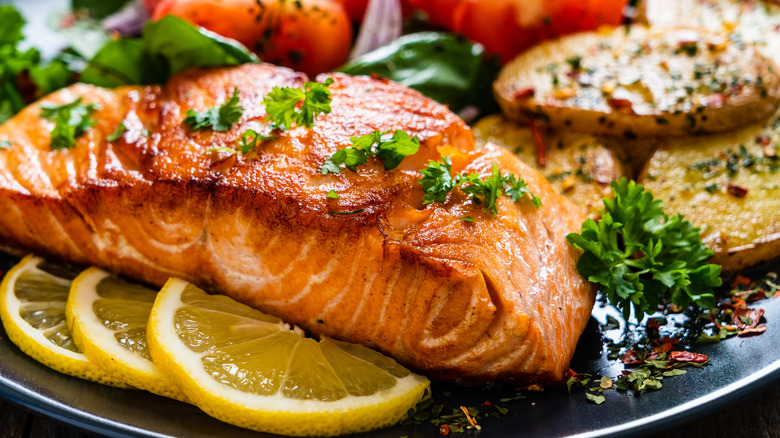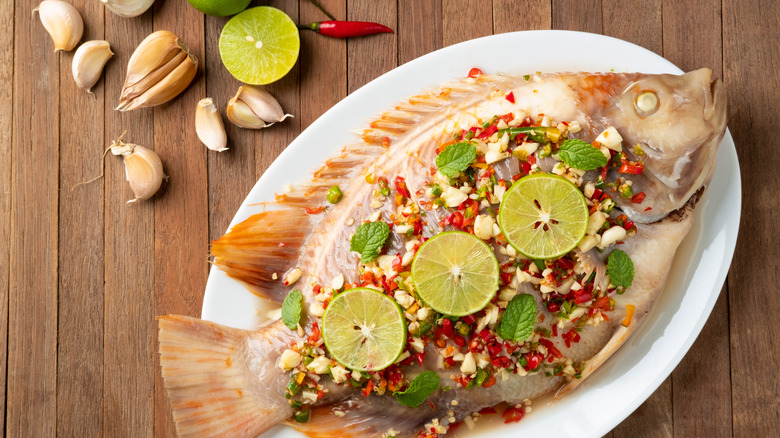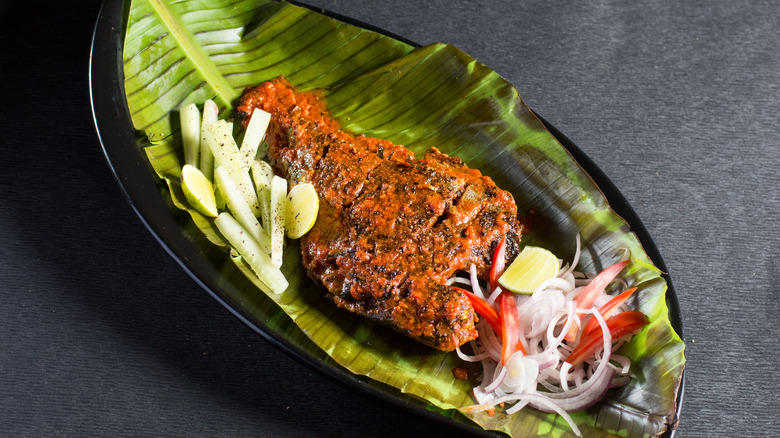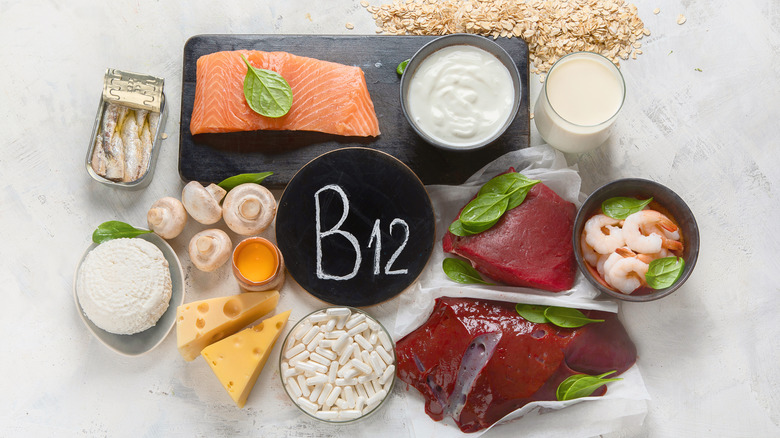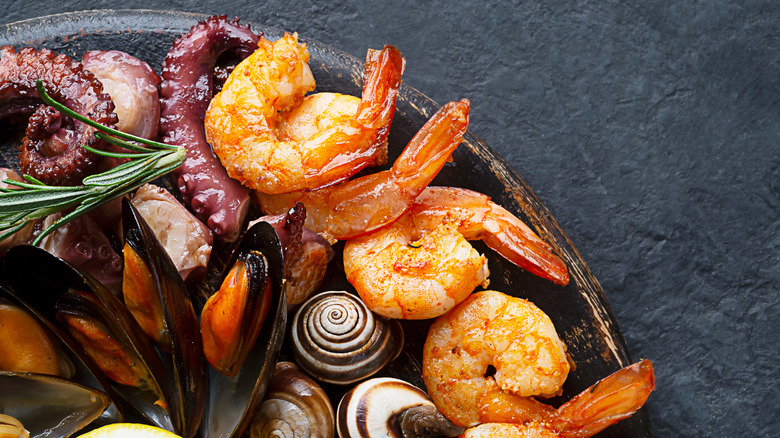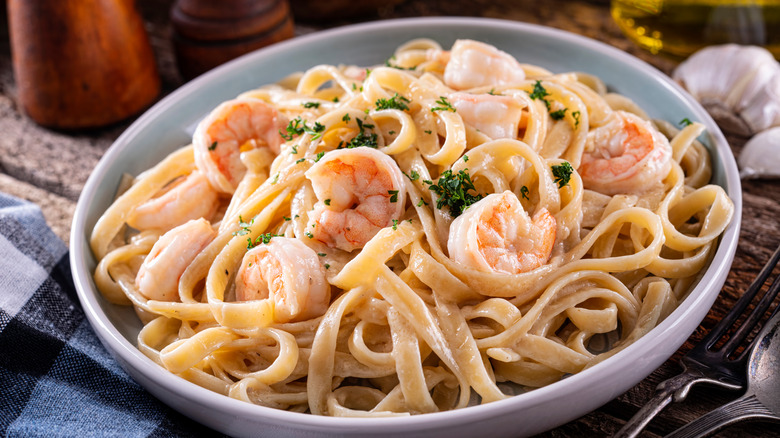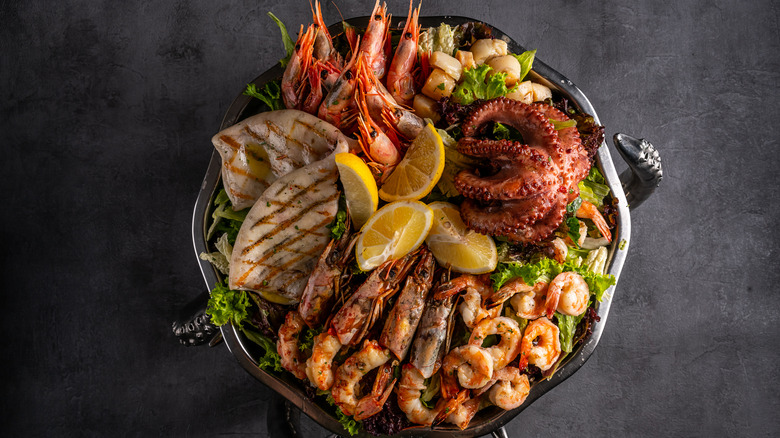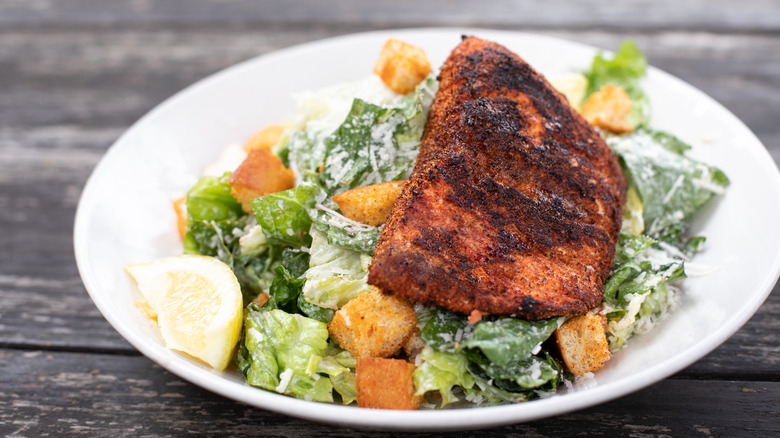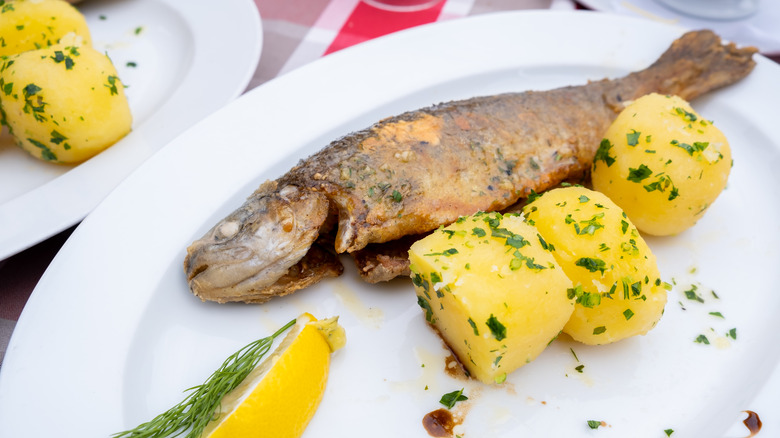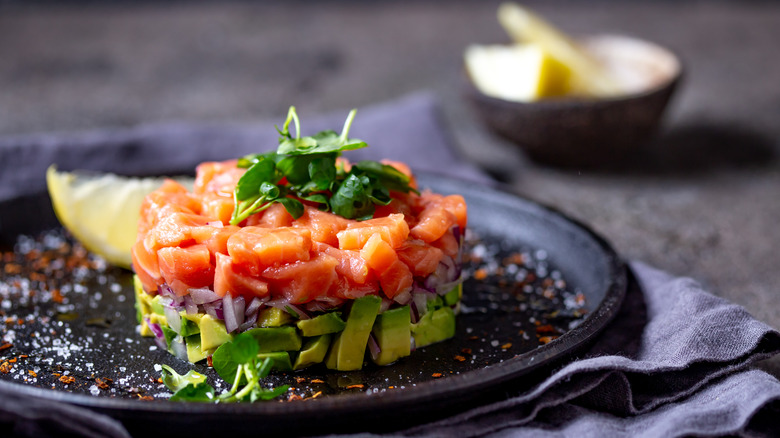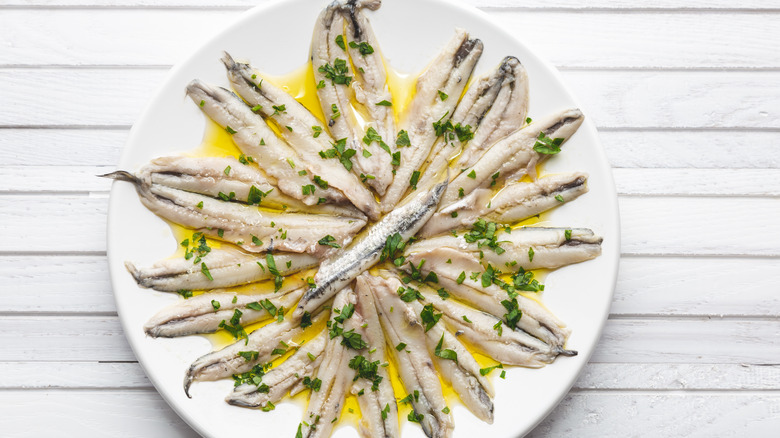Mistakes Everyone Makes When Ordering Fish
There are a lot of reasons to appreciate a beautiful fish dinner. Fish, whether it is seafood like shrimp, lobster, oysters, a flaky white fish, or a piece of salmon, is simply delicious. And, under the right circumstances, it can feel like a special treat, regardless of the season or where exactly you may be enjoying it.
But it's more than just delicious and versatile, it's also healthy. So healthy, in fact, that the Food and Drug Administration recommends you eat at least 2 to 3 servings of seafood each week. That said, along the road to all that delicious and healthy food, there are a whole lot of mistakes that we can make when ordering or eating fish.
These mistakes may arise in how we order fish, from when we order it to how it may be prepared, to even what we may be eating it with. It all sounds pretty complicated — especially when some of the best ways to enjoy fish are raw or simply grilled — but thankfully, knowledge is power. Yes, there are a whole lot of flubs that can make fish downright unappetizing or even unhealthy to eat, but we're here to help you avoid these common mistakes everyone makes when ordering fish!
Ordering fish on a Monday
It may seem that one day is as good as any other to order fish, but the reality is the day of the week really does matter when ordering that blackened salmon or seared scallops.
In fact, one of the greatest celebrity chefs of his time, the late Anthony Bourdain, has been quoted saying he never ate fish on Mondays because it's probably pretty old. Bourdain warned that, if you order fish on a Monday, there's every reason to believe that fish is leftover from the restaurant's seafood order for the weekend. This means that fish was delivered on Friday, giving it multiple days to lose its freshness.
Bourdain wasn't the only chef to feel this way."Fish orders almost never come in on Sundays or Mondays, so [ordering on Monday] means you're probably eating the old fish," Devan Cameron, chef and owner of food website Braised & Deglazed, told Mashed.
That said, this avoidance of fish on Mondays isn't necessarily a hard and fast rule for all restaurants. Indeed, some restaurants get their fish delivered every day. But if you're not sure, it's best to err on the side of caution. "If you don't trust the restaurant, then don't order fish on a Sunday or Monday," said Cameron.
Going for the manager's special
It may stand to reason that the manager's special at a restaurant is probably what's really good and worth a try. After all, why would it be a manager's special otherwise? That's sometimes true, but it's also sometimes one of the diciest things you could order.
"Special" is sometimes a tricky word in a restaurant. In some places, that can mean everything from the fact that it's fridge clean-out day, to the possibility that the chef is trying to manage a surplus of an ingredient that they are trying to get out of their kitchen as soon as possible. For many diners, that aging fish can quickly sound like too much of a risky proposition.
Fish specials can be something to avoid if you don't trust the restaurant or chef or you can't quite pin down why a special is deemed a special. "In a good restaurant, the fish special is a fresh catch of a limited amount of fish that will likely sell out quickly. In a bad restaurant, the fish special is a way to use up fish that's about to go bad," Cameron told Mashed. Well, that's certainly a lot less appealing.
Asking for cheese with a fish order
While everyone is entitled to their personal taste and there are definitely exceptions to almost every culinary no-no, it's generally frowned upon to mix cheese and fish. Mostly, this is based on respecting the delicate flavors of many varieties of fish, which can't always stand up to, say, a salty Parmesan or a piece of pungent blue cheese. Generally, the delicate flavor of seafood can be drowned out by the heavy, rich texture of cheese. And why would you want to overpower something as delicious as a fresh piece of ahi tuna or a glorious piece of king salmon?
That said, there are always some defectors. "We've got a spaghetti alle vongole on our menu that's delicious on its own," said Cameron. "Some people ask to have Parmesan cheese with [this] clam pasta, but this is a bad choice because these two don't go very well together. The Parmesan cheese makes the clams taste old instead of fresh and light, like how we prepare it. There's a reason we didn't add the cheese to the dish."
Ultimately, we strongly urge you to respect the fish and enjoy it on its own terms, sans cheese. Remember, you can always save the cheese for pasta or pizza.
Not checking if the fish is sustainably harvested
Fish can be delicious and healthy, but how healthy it is for you often depends on where that fish comes from, as well as how it lived its life while it was alive. In this case, seafood sustainability is the name of the game.
It's important to know the origins of the fish options before you make your order, then make smart choices based on what is available. "Easily the most significant mistake people make when ordering seafood meals is not quickly researching the sustainability of the fish being ordered," Jessica Randhawa, the head chef and writer behind The Forked Spoon, told Mashed.
In an age when everyone has a computer with high-speed internet in their pocket, checking the sustainability of the fish on the menu takes less than a minute, thanks to resources like the Monterey Bay Aquarium Seafood Watch. If you're trying to make healthy choices with seafood and other ingredients — like, say, avoiding fish with high levels of mercury — it's worth taking those extra few steps to ensure that item actually is healthy, both for you and for the rest of the planet.
Pairing the fish with too much rich food
One mistake people make when ordering fish in a restaurant is having a course before the fish that is too rich and will potentially overpower the seafood. "If you are having fish as your main entrée, is not a good idea to have an appetizer that's gamey such as lamb, bison or pheasant because it will change your palate in a way that you won't be able to enjoy the delicacy of a soft flaky fish," Omar Torres, bartender and Food & Beverage Director at Bonsai at Hilton Pensacola Beach, told Mashed.
And while we're talking about it, when you're actually eating the fish, it's probably best to avoid cream sauce. "It does not do the fish any favors, masking both its texture and flavor," Rowena Murakami, co-founder and master chef of Tiny Kitchen Divas blog, told Mashed. Depending on how it's cooked, you might even be confused if you're eating fish or chicken.
It's often important to think of how your meal will through courses in a way that other foods won't take away from the delicacy of a seafood main like fish. The idea is to pair that fish with ingredients that complement it, versus taking away from the texture and flavor. "Go for what goes well with its natural sweetness. Ginger and citrus-based sauces are my recommendations, for these do not overpower the fish," said Murakami.
Sticking with the same old order
One of the beautiful things about seafood is how versatile it truly is. Whether you're enjoying sushi or sashimi, or fish that's been seared, grilled, or fried, there is a universe of seafood varieties and preparation styles out there for you to enjoy. That's why it's a mistake to allow yourself to get stuck in a rut and always go for the same thing — even if you may consider it a favorite!
Dining out at a restaurant is the perfect opportunity to branch out and try a new species of seafood or preparation style that you haven't tried before. And don't think you have to get twisted up into mental knots trying to figure out what to order. "If you always order shrimp or salmon, ask what the local catch is that day and try a new species," Rima Kleiner registered dietician and blogger at Dish on Fish, told Mashed.
You may just find a new favorite, after all. Even if you don't, it's always fun to explore new flavors and branch out a bit. Try some new things, or, if you're really reluctant, you may be able to go for some sort of mixed assortment. Do so, and you'll have a better idea of what's out there and what you may like to order next time.
Not asking about how fish is cooked
Fish preparation styles, like many other cooking methods, can be kind of confusing, especially if you are new to the world of seafood. Not sure what poached or pan-fried or blackened means? What the heck is the sous vide method, anyway? Don't be afraid to ask! You may learn that it's something you'd love, or perhaps that you'll decide to steer clear and just order something else instead.
If a menu uses a term you're not familiar with, simply ask the server or chef to explain how the seafood is cooked. It can seriously help to inform your decision. "If you're looking for a light option, stick with grilled, poached, seared, broiled, roasted or blackened. For a heavier option, there is fried, battered or buttered," said Kleiner.
Asking these questions will also give you an idea if it's an ingredient or style you need to watch out for. For example, if you are monitoring your fat intake or overall daily calories, you may not want to get fried fish. The breading, salt, and added oils needed for frying can rack up the calories pretty quickly, so a lighter method could be the way to go. And don't be afraid to politely ask if you can change up the preparation method. "If a menu lists a seafood dish as deep-fried or battered, it never hurts to ask if the restaurant will broil or blacken instead," said Kleiner.
Ordering fish fried when it's meant to be grilled (or vice versa)
One of the mistakes people make when ordering fish is ordering a fish grilled that is meant to be fried or vice versa. Although people may have their preference to only order fish grilled or fried, the truth is some fish are just better prepared one way. For example, "Lake trout is meant to be fried, [as] it will not hold the flavor well when grilled," says Miketa Davis, co-owner of LuLu's Maryland-style Chicken and Seafood.
The same could be said with salmon. "Salmon is better grilled and holds so much more flavor than when fried, even though fried salmon has become popular," Davis says. But some varieties of seafood are a little more versatile. Lighter fish such as tilapia or whiting can be grilled or fried without jeopardizing the flavor and quality, said Davis.
Consider asking what kind of cooking style or seafood the particular restaurant specializes in or if they can make suggestions based on your food preference. Restaurants typically want to please their customers without jeopardizing the quality of their food, after all, and it's very possible when ordering you won't even know the proper way to order something until you ask.
Ignoring the appetizer menu
Perhaps you are picking a soup or salad as an appetizer and then moving on and considering the fish options as an entrée. While that's a perfectly good way to eat dinner — it is your dinner after all! — you're missing out on a whole part of the menu that you may actually enjoy.
If you only order seafood from the entrée section, you may be missing out on some seriously delicious and intriguing fishes and other seafood offerings. Mussels, shrimp, and tuna often appear on the starter menu, for instance. "A seafood appetizer makes a great way to start your meal, or even as the meal itself," said Kleiner. Plus, many seafood appetizers tend to be prepared healthfully, simply, and in smaller portion sizes, which may fit well with your dietary needs.
Plus, this method is ideal for newbies or indecisive diners. Ordering fish as an appetizer is a great way to sample something without committing to a larger entrée-sized portion. You can always go for the bigger portion next time though if you like it!
Skipping the anchovies
Anchovies have admittedly gotten a pretty bad reputation as an unappealing or overly pungent and, well, fishy ingredient. Don't be so quick to dismiss this seemingly humble little fish, however, as its unique flavor is actually quite essential to many dishes. Asking to hold or substitute the anchovies in any given dish is cutting out a whole lot of potential flavor that you don't even know you are missing.
"Anchovies are pound for pound one of the greatest umami-rich ingredients used in cooking," Haidar Karoum, the chef and owner of Restaurant Chloe told Mashed. They are the secret ingredient that brings the flavor to much-loved classics like Caesar salad, Vietnamese pho, and spicy pasta puttanesca. "Removing anchovies removes all of the magic they contribute to a dish," said Karoum. Imagine aioli without garlic, pesto without pine nuts, cacio e pepe without black pepper or pecorino ... you get the point.
"Consider getting past the notion that anchovies are offensively fishy or salty and consider all the greatness they provide," said Karoum. Chances are good that you'll be glad you did.
